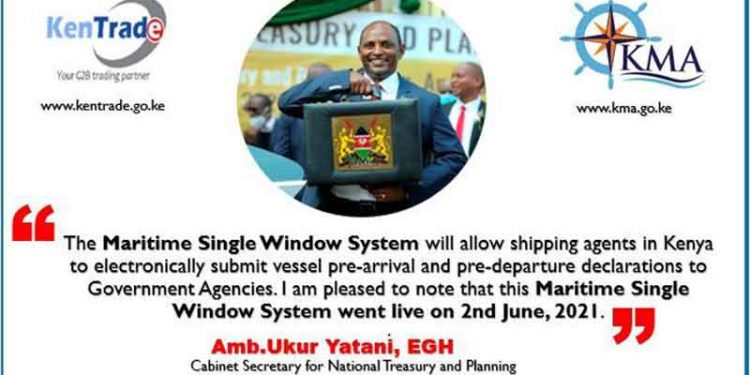The Maritime Single Window System (MSWS) that was launched last week will enhance the country’s Ease of Doing Business ranking and Kenya’s competitiveness in maritime trade. The new system comes when the country has recognized the critical role played by the Blue Economy in the economic growth of our country.
“The development and exploitation of the Blue Economy has the potential to contribute to the attainment of the “Big Four” initiatives because of its enormous forward and backward linkages with other productive sectors in wealth and employment creation especially in food security, the service sector and manufacturing,” Cabinet Secretary Ukur Yatani said when he addressed participants virtually during the system’s launch last week.
The government, he added, was keen on identifying and addressing any challenges that may hinder the growth of the maritime sector.
“As part of the Blue Economy initiatives, the rollout of the Maritime Single Window will therefore play a key role in ensuring efficient and timely delivery of pre-clearance services to ships, cargo and crew making Kenya an attractive shipping destination with improved port efficiency, ship turnaround time and port productivity,” he added.
The Maritime Single Window System has enabled Kenya to comply with its international obligation as a signatory of the International Maritime Organization FAL (Facilitation of Maritime Traffic) Convention. The convention requires all member states to automate passenger and ship clearance procedures through implementing an electronic Maritime Single Window System (MSWS) by 1st January 2019 when the convention came into full effect.
The convention was informed by the fact that ships, ship crew members, goods and passengers involved in international maritime trade are subjected to a range of government controls, both on arrival and departure. Systems to process these requirements have not been centralized or digitized for a long time resulting in unnecessary delays and costs.
The system has come at time the Port of Mombasa has recorded a significant growth of cargo volumes. In 2019, the Mombasa port’s overall cargo throughput rose to 34.44 million tonnes, up from 30.92 million the previous year, marking a growth of 11.4 percent.
Total transit throughput also posted a growth of 3.6 percent to 9.95 million tonnes in 2019 with Uganda maintaining its dominance in this segment, controlling 23.6 per cent of the total port throughput and 81.8 percent of the total transit traffic.
It is projected that the capacity to handle containers will grow from about 1.85 million TEUs to 2.75 million TEUs.
“It is therefore expected that the MSWS will not only support the existing ships docking at our ports but will also make our ports more attractive to other vessels and contribute to the growth in the throughput,” Yatani said.
The President in May this year, commissioned the Lamu as the second commercial port in Kenya, which is expected to transform the shipping and maritime industry in Africa.
The Lamu Port is strategically at the middle of major shipping routes and its operationalization will enable Kenya to realize long cherished goals of opening northern Kenya to international trade, fortifying the country’s position as a major gateway to Africa, and harnessing the economic potential of the historically under-served region.
Meanwhile, the Treasury recently finalized the automation of the Duty Remission Scheme which was previously managed manually where the end user was required to submit manual applications to The National Treasury.
“We have worked with KenTrade and KRA to automate this process and this is expected to facilitate faster lodgement and processing of applications,” Yatani said, adding that the module will also improve accountability and bring efficiency in managing the Duty Remission Scheme.
It is now mandatory for importers under the East African Community Duty Remission Scheme to lodge their applications online through the Kenya TradeNet System.
The Treasury has also embarked on automating the process for requesting, processing and granting of tax exemptions, waiver, variation or remission on a national tax, a fee or a charge through the automation of the Project Master list process.





